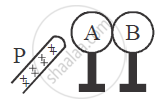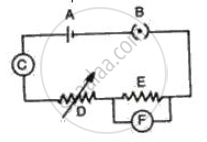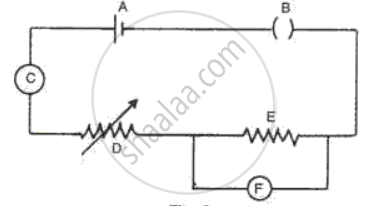Advertisements
Advertisements
प्रश्न
Calculate the electric field in a copper wire of cross-sectional area 2.0 mm2 carrying a current of 1 A.
The resistivity of copper = 1.7 × 10–8 Ω m
उत्तर
Given:-
Area of cross-section, A = 2 × 10–6 m2
Current through the wire, i = 1 A
Resistivity of copper, ρ = 1.7 × 10–8 Ωm
Resistance of a wire,
\[R = \rho\frac{l}{A}\]
Also from Ohm's Law, voltage across a wire,
\[V = iR = \frac{i\rho l}{A}\]
The electric field of the wire,
\[E = \frac{V}{l}\]
Now:
`R = (fl)/A`
`= (1.7xx10^(-8)xxl)/(2xx10^-6)`
`V = iR = (1 xx1.7xx10^-8xxl)/(2xx10^-6)`
`E = (dV)/(dL) = V/l`
`= (1.7xx10^-8)/(2xx10^-6`
`= 1.7/2xx10^-2`
`= 17xx10^-3`
`= 8.5xx10^-3`mv/m.
APPEARS IN
संबंधित प्रश्न
Find the expression for the resistivity of a material and state the SI unit of resistivity.
The graph between V and I for a conductor is a straight line passing through the origin.
What should remain constant in a statement of this law?
Four resistances of 16 ohms each are connected in parallel. Four such combinations are connected in series. What is the total resistance?
Which of the following is an ohmic resistance?
A wire of resistance 3 ohm and length 10 cm is stretched to length 30 cm. Assuming that it has a uniform cross section, what will be its new resistance?
Two metallic spheres A and B kept on insulating stands are in contact with each other. A positively charged rod P is brought near the sphere A as shown in the figure. The two spheres are separated from each other, and the rod P is removed. What will be the nature of charges on spheres A and B?

Fig. represents the circuit used for the verification of ohm's law. Label the different parts from A and F. State the function of each.

Tick(✓) the correct choice in the following:
Ohm's law is applicable to
Fig. represents the circuit used for the verification of Ohm's law. Label the parts from A to F. state the function of each.

State the relation correlating the electric current flowing in a conductor and the voltage applied across it. Also, draw a graph to show this. relationship.
The ratio of the potential difference to the current is known as ________.
Obtain the macroscopic form of Ohm’s law from its microscopic form and discuss its limitation.
An electronics hobbyist is building a radio which requires 150 Ω in her circuit, but she has only 220 Ω, 79 Ω, and 92 Ω resistors available. How can she connect the available resistors to get the desired value of resistance?
The temperature of a conductor is increased. The graph best showing the variation of its resistance is:

Calculate the total resistance of the circuit and find the total current in the circuit.
Consider a current carrying wire (current I) in the shape of a circle. Note that as the current progresses along the wire, the direction of j (current density) changes in an exact manner, while the current I remain unaffected. The agent that is essentially responsible for is ______.
State Ohm's Law. Represent it mathematically.
What is the resistance of a conductor through which a current of 0.5 A flows when a potential difference of 2V is applied across its ends?
You are provided with a resistor, a key, an ammeter, a voltmeter, four cells of 1.5 V each and few connecting wires. Using circuit components, draw a labelled circuit diagram to show the setup to study Ohm's law.
State the relationship between potential difference (V) across the resistor and the current (I) flowing through it. Also draw V-I graph, taking V on the X-axis.
How is electric current related to the potential difference across the terminals of a conductor?
Draw a labelled circuit diagram to verify this relationship.
